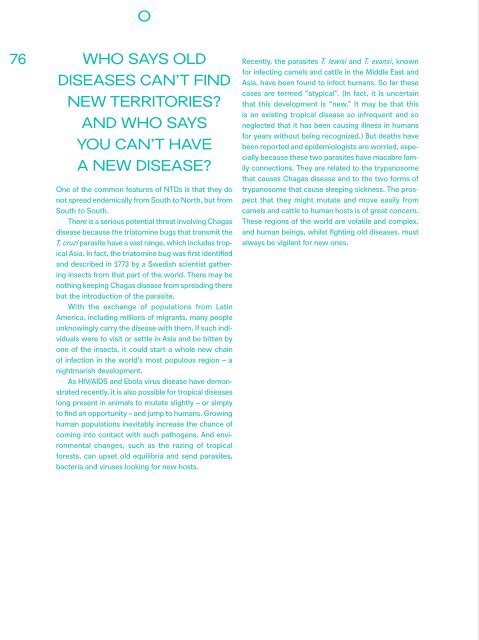You also want an ePaper? Increase the reach of your titles
YUMPU automatically turns print PDFs into web optimized ePapers that Google loves.
O<br />
76<br />
WHO SAYS OLD<br />
DISEASES CAN’T FIND<br />
NEW TERRITORIES?<br />
AND WHO SAYS<br />
YOU CAN’T HAVE<br />
A NEW DISEASE?<br />
One of the common features of NTDs is that they do<br />
not spread endemically from South to North, but from<br />
South to South.<br />
There is a serious potential threat involving Chagas<br />
disease because the triatomine bugs that transmit the<br />
T. cruzi parasite have a vast range, which includes tropical<br />
Asia. In fact, the triatomine bug was first identified<br />
and described in 1773 by a Swedish scientist gathering<br />
insects from that part of the world. There may be<br />
nothing keeping Chagas disease from spreading there<br />
but the introduction of the parasite.<br />
With the exchange of populations from Latin<br />
America, including millions of migrants, many people<br />
unknowingly carry the disease with them. If such individuals<br />
were to visit or settle in Asia and be bitten by<br />
one of the insects, it could start a whole new chain<br />
of infection in the world’s most populous region – a<br />
nightmarish development.<br />
As HIV/AIDS and Ebola virus disease have demonstrated<br />
recently, it is also possible for tropical diseases<br />
long present in animals to mutate slightly – or simply<br />
to find an opportunity – and jump to humans. Growing<br />
human populations inevitably increase the chance of<br />
coming into contact with such pathogens. And environmental<br />
changes, such as the razing of tropical<br />
forests, can upset old equilibria and send parasites,<br />
bacteria and viruses looking for new hosts.<br />
Recently, the parasites T. lewisi and T. evansi, known<br />
for infecting camels and cattle in the Middle East and<br />
Asia, have been found to infect humans. So far these<br />
cases are termed “atypical”. (In fact, it is uncertain<br />
that this development is “new.” It may be that this<br />
is an existing tropical disease so infrequent and so<br />
neglected that it has been causing illness in humans<br />
for years without being recognized.) But deaths have<br />
been reported and epidemiologists are worried, especially<br />
because these two parasites have macabre family<br />
connections. They are related to the trypanosome<br />
that causes Chagas disease and to the two forms of<br />
trypanosome that cause sleeping sickness. The prospect<br />
that they might mutate and move easily from<br />
camels and cattle to human hosts is of great concern.<br />
These regions of the world are volatile and complex,<br />
and human beings, whilst fighting old diseases, must<br />
always be vigilant for new ones.


